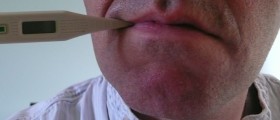About Bilateral Otitis Media
Otitis media is the inflammation of the middle ear. It is a very common medical issue, especially among children. Of all medical problems affecting the ear, otitis media seems to be the most common one. This inflammation can affect one or both ears. If it affects both ears, it is called bilateral otitis media, as opposed to unilateral otitis media, which involves just one ear.
Acute otitis media is a typical childhood disease. As children grow older, the angle between the eustachian tube and the pharynx becomes more acute, so sneezing and coughing can easily push it shut. In younger children, the angle is still not very acute, allowing the material to travel down the tube into the middle ear.

This disease is typical for children between ages of 6 and 15 months. It often resolves on its own, without any special treatment. Since otitis media in children is so frequent and common and it can go away on its own, most of the times parents do not even take the child to see the doctor.
- Clinical status was determined by a clinical/otologic score evaluating severity (0 = absent to 3 = severe, maximal score 12) of patient's fever and irritability and tympanic membrane redness and bulging.
- Multivariate logistic regression models were used to estimate the risk of BAOM and UAOM presenting with a high severity score (> or =8).
- Six-hundred twenty-three (61%) patients had bilateral (BAOM). Positive MEF cultures were recorded in 786 (77%) patients. More patients with BAOM had positive MEF cultures than patients with unilateral (UAOM) (517 of 623, 83% versus 269 of 403, 67%; P
- Nontypable Haemophilus influenzae was more common in BAOM than in UAOM (390 of 623, 63% versus 170 of 430, 42%; P
- Overall, the clinical/otologic score showed higher severity in culture-positive than in culture-negative patients (8.2 +/- 2.0 versus 7.7 +/- 2.2; P or =8 was more frequent in BAOM than in UAOM patients (371, 61.8% versus 200, 51.3%; P = 0.001). The estimated risk for BAOM patients (compared with UAOM patients) to present with a score > or =8 was 1.5.
- The association between BAOM and clinical/otologic score > or = 8 was maintained after adjustment for age, previous AOM history, and culture results at enrollment.
Otitis media, especially if bilateral, is often associated with viral infections, such as influenza. The inflammation can follow an upper respiratory tract infection, for example, a common cold or flu. Bacterial infection is another, although the less common cause of acute otitis media.
Symptoms of Acute Bilateral Otitis Media
The most prominent symptom of acute bilateral otitis media is earache affecting both of the ears. Headache is also very common, and so is fatigue, malaise, fever, irritability, nausea and vomiting.
Examination at the doctor’s office usually reveals high or very high fever, redness of the eardrum, which may also be bulging or swollen and outer ear that is red and warm to touch.
Treatment for Acute Bilateral Otitis Media
In many cases otitis media goes away on its own. If it persists for more than three or four days, it is advised to see a doctor. Given the nature of this disease, it may be hard to decide if antibiotics are required or not, especially since the infection is often viral. In addition, doctors are often reluctant to give antibiotics to children. However, if the infection is believed to be bacterial and if it is particularly severe, antibiotics can be given in oral form or as antibiotic eardrops.
The pain can be managed with over-the-counter analgesics, such as ibuprofen. Aspirin is not suitable for children because of the risk of rare but dangerous Raye’s syndrome. There are also eardrops with mild numbing or anesthetic agents that can be used to relieve the pain. Paracetamol can be taken to reduce the fever and body ache.

















Your thoughts on this
Loading...